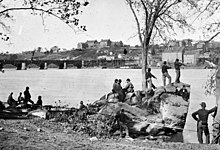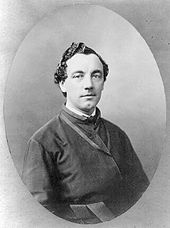Civil War[edit]
The U.S. Civil War greatly affected Georgetown as 1,141 students and alumni enlisted in one army or the other, and the Union Army commandeered university buildings.[10] By the time of President Abraham Lincoln's May 1861 visit to campus, 1,400 troops were living in temporary quarters there. Due to the number of lives lost, enrollment levels remained low until well after the war was over. Only seven students graduated in 1869, down from over 300 in the previous decade.[17] At its founding in 1876, the Georgetown College Boat Club, the school's rowing team, adopted blue, used for Union uniforms, and gray, used for Confederate uniforms, as its colors to signify the peaceful unity among students.[18] Subsequently, the school adopted these as its official colors.
Enrollment did not recover from the war until the presidency of Patrick Francis Healy from 1873 to 1881. Born a slave by law, Healy was the first acknowledged head of a predominantly white American university with African heritage.[b] He is credited with reforming the undergraduate curriculum, lengthening the medical and law programs, and creating the Alumni Association. One of his largest undertakings was the construction of a major new building, subsequently named Healy Hall in his honor. For his work, Healy is known as the school's "second founder."[19]
Expansion[edit]
After the founding of the Law Department in 1870, Healy and his successors hoped to bind the professional schools into a university, and focus on higher education.[14] The School of Medicine added a dental school in 1901 and the undergraduate School of Nursing in 1903.[20] Georgetown Preparatory School relocated from campus in 1919 and fully separated from the University in 1927.[21] The School of Foreign Service (SFS) was founded in 1919 by Edmund A. Walsh, to prepare students for leadership in diplomacy and foreign commerce.[14]The School of Business was created out of the SFS in 1957, and in 1998 was renamed the McDonough School of Business in honor of alumnus Robert E. McDonough.[22]
Besides expansion of the University, Georgetown also aimed to expand its resources and student body. The School of Nursing has admitted female students since its founding, and most of the university was made available on a limited basis by 1952.[23] With the College of Arts and Sciences welcoming its first female students in the 1969–1970 academic year, Georgetown became fully coeducational.[24] Georgetown ended its bicentennial year of 1989 by electing Leo J. O'Donovan as president. He subsequently launched the Third Century Campaign to build the school's endowment.[25] In December 2003, Georgetown completed the campaign after raising over $1 billion for financial aid, academic chair endowment, and new capital projects.[26] John J. DeGioia, Georgetown's first lay president, has led the school since 2001, and has continued its financial modernization and sought to "expand opportunities for intercultural and interreligious dialogue", such as by opening a campus in Qatar.[27]
Jesuit tradition[edit]
Georgetown University was founded by former Jesuits in the tradition of Ignatius of Loyola and is a member of the Association of Jesuit Colleges and Universities.[12][28] Georgetown is not a pontifical university, though seven Jesuits serve on the thirty-six member Board of Directors, the school's highest governance.[29] Fifty-two members of the Society of Jesus live on campus, and are mostly employed by Georgetown as professors or administrators.[30] Jesuit Heritage Week has been held every year since 2001 to celebrate the contributions of Jesuits to the Georgetown tradition.[31]
The role that Georgetown's Catholic heritage has played in its policies has been controversial at times, even as its influence is relatively limited.[32] Stores in University-owned buildings are not allowed to sell or distribute birth control products.[33] Georgetown University Medical Center and Georgetown University Hospital, operated by MedStar Health, are prohibited from performing abortions.[34] As recently as 2004, the hospital did perform research using embryonic stem cells.[35] Georgetown has drawn criticism from religious groups such as the Cardinal Newman Society for hosting speeches from prominent pro-choice politicians, including John Kerry and Barack Obama,[36][37] and fromWashington's Archbishop, Donald Wuerl, for inviting Kathleen Sebelius to be a commencement speaker.[38] The university does host the Cardinal O'Connor Conference on Life every January to discuss the pro-life movement.[39]
Between 1996 and 1999, crucifixes were added to many classroom walls, attracting national attention.[40] Before 1996, crucifixes had hung only in hospital rooms and historic classrooms.[41] Some of these crucifixes are historic works of art, and are noted as such.[42] According to Imam Yahya Hendi, the school's on-campus Muslim cleric, pressure to remove the crucifixes comes from within the Catholic community, while he and other campus faith leaders have defended their placement.[43] The Intercultural Center is an exception to this controversy, rotating displays of various faith and culture symbols in the lobby.[44]



No comments:
Post a Comment